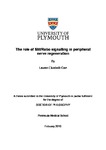The Role of Slit/Robo Signalling in Peripheral Nerve Regeneration
| dc.contributor.supervisor | Dun, Xin-Peng | |
| dc.contributor.author | Carr, Lauren | |
| dc.contributor.other | Faculty of Health | en_US |
| dc.date.accessioned | 2019-03-06T09:22:26Z | |
| dc.date.available | 2019-03-06T09:22:26Z | |
| dc.date.issued | 2019 | |
| dc.identifier | 10473843 | en_US |
| dc.identifier.uri | http://hdl.handle.net/10026.1/13433 | |
| dc.description | Expression patterns of Slit and Robo family members in adult mouse spinal cord and peripheral nervous system Carr L, Parkinson DB, Dun Xp (2017) Expression patterns of Slit and Robo family members in adult mouse spinal cord and peripheral nervous system. PLOS ONE 12(2): e0172736. https://doi.org/10.1371/journal.pone.0172736 | en_US |
| dc.description.abstract |
The role of Slit/Robo signalling in peripheral nerve regeneration. Slit/Robo chemorepulsive signalling has been shown to play a role in axon pathfinding during the development of the central nervous system. There is evidence that Slit/Robo are expressed in the adult intact and injured peripheral nervous system. Owing to their role in axon pathfinding during development it is plausible that Slit/Robo signalling could also play a role in axon pathfinding following peripheral nerve transection injury where axons must find their way across the newly-formed nerve bridge. This project aimed to study the expression pattern of Slit and Robo family members in both the intact and injured adult peripheral nervous system to establish a potential role for Slit/Robo signalling in peripheral nerve repair. A range of methods were employed to look at the expression of Slit/Robo’s at both the mRNA and protein levels. These included RT-PCR and in situ hybridisation to look at mRNA levels and immunohistochemistry and western blotting to determine protein levels. Staining was carried out on both mouse adult intact sciatic nerves and transected sciatic nerves. To establish the role of Slit/Robo during peripheral nerve regeneration, Slit/Robo mutant mice underwent a sciatic nerve transection to replicate a peripheral nerve injury; nerves were removed and underwent whole mount staining to establish axon regeneration patterns. Our results revealed a diverse expression pattern of Slit/Robos in the intact mouse sciatic nerve at both the mRNA and protein levels. Slit/Robos were expressed in a range of cells in the sciatic nerve including Schwann cells, axons, endothelial cells, fibroblasts and the cell bodies of sciatic nerve neurons. During peripheral nerve regeneration, Slit3 was expressed strongly in macrophages surrounding the nerve bridge, while cells infiltrating into the nerve bridge expressed Robo1 strongly. The Slit2, Slit3 and Robo1 single adult mutants show normal sciatic nerve morphology, but Slit3 and Robo1 single and double mutants had severely disrupted axon trajectories following sciatic nerve transection. However, Robo1 mutants did not have any apparent defects in recovery following a crush injury. Slit and Robos family members are expressed in the adult mouse sciatic nerve, and this signalling pathways presence is likely linked to maintenance of the peripheral nerve structure. Slit3-Robo1 signalling plays a crucial role in correct cell trajectory over the nerve bridge following sciatic nerve transection in mice. | en_US |
| dc.language.iso | en | |
| dc.publisher | University of Plymouth | |
| dc.subject | Slit | en_US |
| dc.subject | Robo | en_US |
| dc.subject | Peripheral nerve regeneration | en_US |
| dc.subject | Schwann cells | en_US |
| dc.subject | in vivo | en_US |
| dc.subject | Macrophages | en_US |
| dc.subject | Slit3 | en_US |
| dc.subject | Robo1 | en_US |
| dc.subject | Axon regeneration | en_US |
| dc.subject | nerve injuries | en_US |
| dc.subject | conduit | en_US |
| dc.subject.classification | PhD | en_US |
| dc.title | The Role of Slit/Robo Signalling in Peripheral Nerve Regeneration | en_US |
| dc.type | Thesis | |
| plymouth.version | publishable | en_US |
| dc.identifier.doi | http://dx.doi.org/10.24382/1171 | |
| dc.rights.embargoperiod | No embargo | en_US |
| dc.type.qualification | Doctorate | en_US |
| rioxxterms.version | NA |
Files in this item
This item appears in the following Collection(s)
-
01 Research Theses Main Collection
Research Theses Main


